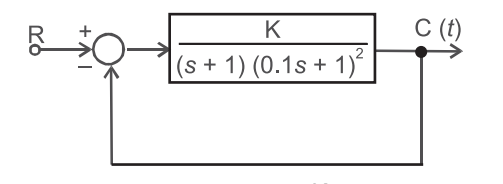Control systems miscellaneous
- The transfer function C (s)/ R (s) of the system, whose block diagram is given below is—

-
View Hint View Answer Discuss in Forum
Here in the given block diagram there are two loop, on simplifying, we get
C(s) = G1·G2 R(s) (1 + G1H1) (1 + G2H2) = G1·G2 1 + G1H1 + G2H2 + G1G2H1H2 
Correct Option: B
Here in the given block diagram there are two loop, on simplifying, we get
C(s) = G1·G2 R(s) (1 + G1H1) (1 + G2H2) = G1·G2 1 + G1H1 + G2H2 + G1G2H1H2 
- For the unity feedback system shown below, the steady state, when the input is
R = 3 - 1 + 1 s s2 2s3
would be—
-
View Hint View Answer Discuss in Forum
ess = s → 0Lim sE (s) = s → 0Lim s·R(s) 1 + G(s)H(s) = s → 0Lim s 
3 - 1 + 1 
1 + 4(s + 1)/s2(s + 2).1 s s2 2s3 = s → 0Lim s3(s + 2) 
3 - 1 + 1 
s3 + 2s2 + 4s + 4 s s2 2s3
= 0 + 0 + 1/4 = 1/4Correct Option: A
ess = s → 0Lim sE (s) = s → 0Lim s·R(s) 1 + G(s)H(s) = s → 0Lim s 
3 - 1 + 1 
1 + 4(s + 1)/s2(s + 2).1 s s2 2s3 = s → 0Lim s3(s + 2) 
3 - 1 + 1 
s3 + 2s2 + 4s + 4 s s2 2s3
= 0 + 0 + 1/4 = 1/4
- The system shown in the given figure has a unit step input. In order to make the steady state error 0.1, the value of K required is—

-
View Hint View Answer Discuss in Forum
Given r (t) = u (t) then
R (s) = 1 s G(s) = K (s + 1)(0.1s + 1)2
H (s) = 1
ess = s → 0Lim sE (s)E(s) = 1 R(s) 1 + G(s) H(s) E(s) = R(s) 1 + G(s) H(s) = 1/s 1 + K/(s + 1)(0.1 + 1)2 ×1 = (s + 1)(0·1s + 1)2 s{(s + 1) (0.1 + 1)2 + K} ess = s → 0Lim s·(s + 1)(0·1s + 1)2 s{(s + 1) (0.1 + 1)2 + K} 0·1 = 1 × 1 (1 × 1 × K)
or ·
1 + ·1K = 1 ·1 K = 1 – ·1 = ·9
K = 9
Correct Option: D
Given r (t) = u (t) then
R (s) = 1 s G(s) = K (s + 1)(0.1s + 1)2
H (s) = 1
ess = s → 0Lim sE (s)E(s) = 1 R(s) 1 + G(s) H(s) E(s) = R(s) 1 + G(s) H(s) = 1/s 1 + K/(s + 1)(0.1 + 1)2 ×1 = (s + 1)(0·1s + 1)2 s{(s + 1) (0.1 + 1)2 + K} ess = s → 0Lim s·(s + 1)(0·1s + 1)2 s{(s + 1) (0.1 + 1)2 + K} 0·1 = 1 × 1 (1 × 1 × K)
or ·
1 + ·1K = 1 ·1 K = 1 – ·1 = ·9
K = 9
-
Given G(s) = 1 - Is s(s + 2)
The system with the transfer function is operated in a close-loop with unity feedback. The closed loop system is—
-
View Hint View Answer Discuss in Forum
Given
G(s) = 1 - s s(s + 2)
H (s) = 1T.F. = C(s) = G(s) R(s) 1 + G(s) H(s) C(s) = 1 -s/s(s + 2) R(s) 1 + (1 - s)/s(s + 2)× 1 C(s) = 1 - s R(s) s2 + 2s + 1 - s C(s) = 1 - s R(s) s2 + s + 1
the C.E. equation = s2 + s + 1
R.H.C.
s2 1 1
s1 1 0
s0 1
since all the element in the first column are positive hence the system is stable. Alternative (A) is the correct answer.
NOTE : In such type of questions on seeing first time it seems to be unstable system, as we realize that one zero in the R.H.S., so the system will be unstable, but actually not.Correct Option: A
Given
G(s) = 1 - s s(s + 2)
H (s) = 1T.F. = C(s) = G(s) R(s) 1 + G(s) H(s) C(s) = 1 -s/s(s + 2) R(s) 1 + (1 - s)/s(s + 2)× 1 C(s) = 1 - s R(s) s2 + 2s + 1 - s C(s) = 1 - s R(s) s2 + s + 1
the C.E. equation = s2 + s + 1
R.H.C.
s2 1 1
s1 1 0
s0 1
since all the element in the first column are positive hence the system is stable. Alternative (A) is the correct answer.
NOTE : In such type of questions on seeing first time it seems to be unstable system, as we realize that one zero in the R.H.S., so the system will be unstable, but actually not.
- The transfer function of transportation lag is e–sT. If the lag is small as compare to the time constant of the system, it can be approximated by—
-
View Hint View Answer Discuss in Forum
On expanding
e–sT = 1 + (–sT) + (–sT)2 +........... L2
e–sT = 1 – sT neglecting higher order terms.Correct Option: C
On expanding
e–sT = 1 + (–sT) + (–sT)2 +........... L2
e–sT = 1 – sT neglecting higher order terms.

